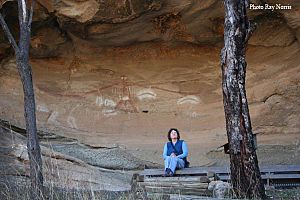Baiame Cave facts for kids
Quick facts for kids Baiame Cave |
|
|---|---|

Baiame Cave with rock art, 2007
|
|
| Location | Milbrodale, Singleton Council, New South Wales, Australia |
| Owner | Owner of land where Baiame Cave is situated |
| Official name: Baiame Cave; Milbrodale Man; Baiame’s Cave; Creator Cave; Dhurramulan; Going; Wabooee; Baiamai; Biami; Baimae; Biamie; Biaime; Byarmie; Byarme; | |
| Type | state heritage (archaeological-terrestrial) |
| Designated | 31 July 2015 |
| Reference no. | 1942 |
| Type | Art site |
| Category | Aboriginal |
| Lua error in Module:Location_map at line 420: attempt to index field 'wikibase' (a nil value). | |
Baiame Cave is a special cave in Milbrodale, Australia. It holds ancient Aboriginal rock art. This amazing site is also known by many other names, like Baiame’s Cave or Creator Cave. It was added to the New South Wales State Heritage Register in 2015 because of its great importance.
Contents
What is Baiame Cave?
Baiame Cave is a large rock shelter made of sandstone. It sits about 24 metres above the valley floor. The cave faces north-east and looks out over the beautiful Hunter Valley. You can see Singleton from here.
The people who created this art picked this spot carefully. It was a perfect place to show off the art of Baiame, who is known as the 'Creator'. The cave also offers a wide view of the valley. It's like an outdoor art gallery for the Wonnarua people and visitors. It is close to a water source, making it an ideal gathering spot.
The Amazing Artwork
The main artwork is on the back wall of the cave. It shows a very large figure of a man. This figure is outlined in white and filled with red paint. It has two big white circles for eyes and its arms are stretched out wide. This figure is the most important part of the art.
Around the main figure, there are other smaller pictures. These are called stencils. They include shapes of boomerangs, hands, forearms, and a hafted axe. There might even be a spear. The art closer to the ground has faded a bit over time. But the art higher up is more protected and looks better.
The Cave's Condition
The cave and its art are open to the weather all year. However, the floor slopes, which helps water drain away. This keeps the cave dry. You might see swallow nests in the roof of the cave. There are also some natural cracks in the sandstone walls. One crack goes through Baiame's right arm.
To help people visit safely, a wooden stairway was built in 1993. It leads from a road to a viewing platform near the cave. This platform helps protect the site. The landowners have also looked after the cave for over 40 years. They try to keep animals away and prevent damage. The art is still in its original form, but the colours are slowly fading due to natural weather. Luckily, there hasn't been much vandalism.
Why Baiame Cave is Important
Baiame Cave is a very special spiritual place. It shows the image of the "Creator," Baiame. The way Baiame's arms are stretched out over the land of the Wonnarua people is unique. This makes it an exceptionally rare and important piece of Aboriginal rock art.
The cave and its art are highly respected. Not just by the local Wonnarua people, but by many other Aboriginal groups. People from all over south-east Australia and the wider Hunter Valley community value it.
Stories and Meanings
The artwork of Baiame is a big part of Aboriginal culture and history. It connects to the Creation story of the Wonnarua people. It is also linked to their land and their totem, the Eagle. Baiame Cave is part of a network of important Aboriginal sites across the Hunter Valley and New South Wales.
Baiame is a key figure in many Dreaming stories. These stories are very old and explain how the world was created. Baiame Cave is the only known rock shelter with such a large painted image of the ancestral creator Baiame.
The cave helps the Wonnarua people keep their traditions alive. It's a place where they share oral histories, creation stories, and traditional lore (laws). It is seen as a place of great cultural, social, and spiritual importance.
Words from a Traditional Owner
Victor Perry, a Wonnarua traditional owner, explained the meaning of the artwork:
- The figure in the cave is a powerful deity, or god-like, figure.
- Different Aboriginal groups called him by different names, like Goign (Wonnarua name) or Baiame.
- He is seen as the creator of everything, similar to how some people view God.
- The drawings around Baiame have meanings too. Boomerangs are called boringan in Wonnarua language. Stone axes are called mogos.
- The hand stencils might represent people who looked after the cave and the painting.
- Baiame's long arms show he was believed to be the protector of the land and its people.
- His large eyes mean he was "all-seeing" and had "all knowledge."
- People respected him deeply, just as they do today.

